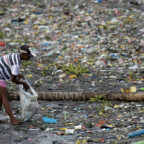
It’s your classic movie eureka moment.
Young researcher Sarah-Jeanne Royer set out to measure methane gas coming from biological activity in sea water. Instead, in a “happy accident” she found that the plastic bottles holding the samples were a bigger source of this powerful warming molecule than the bugs in the water.
Now she’s published further details in a study into the potential warming impact of gases seeping from plastic waste. “It was a totally unexpected discovery,” Dr Royer told BBC News.
“Some members of the lab were experimenting with high density polyethylene bottles looking at methane biological production, but the concentrations were much higher than expected.”
“So we realised that the emissions were not just coming from the biology but from the bottle that we were using for the experiment.”
After graduating from university in Barcelona, Dr Royer found herself in Hawaii, leading teams of volunteers who were helping to remove plastic from beaches at weekends, while working on the chemistry of the substance during the week.
Now she’s published her report after spending a year and a half testing different types of plastic in and out of seawater to see if they emit methane and ethylene, which both contribute to the greenhouse effect.
Dr Royer found that the most widely-used plastic, the stuff used to make shopping bags, is the one that produces the greatest amount of these warming gases.
At the end of the study, after 212 days in the sun, this plastic emitted 176 times more methane than at the start of the experiment.
Ironically, when plastics were exposed to air the amount of methane emitted was double the level from sea water.
What’s causing these emissions?
In short it’s the Sun. Solar radiation acts on the surface of plastic waste. As it breaks down, becomes cracked and pitted, these defects increase the surface area of plastic available to sunlight which accelerates gas production. Even in the dark, the gas continues to seep out.
“I’m in the field every week,” said Dr Royer.
“When I touch a piece of plastic, if there’s a little impact on that plastic it’s degrading into hundred of pieces pretty much as we look at it.”
Is this a big deal?
Up to now, the link between plastics and climate change was mainly focussed on the use of fossil fuels like oil and gas in the manufacture of plastic items.
It’s also known that when plastics degrade in the environment, they release CO2. Experts have welcomed this report as it is the first time that anyone has tried to quantify other warming gases emerging from plastic waste.
“Low density polyethylene (LDPE) does emit ethylene, methane and propane, even at low temperatures that contribute to greenhouse gas emissions,” Prof Ashwani Gupta from the University of Maryland, who was not involved in the study, told BBC News.
“It is nice to see some quantified emissions on greenhouse gases for the selected polyethylene. The results clearly show variation in gas emission levels among the different polyethylene sources.”
While the amounts of methane and ethylene being produced right now from plastics are very small, Dr Royer is concerned about the future and the fact that as plastic breaks down, more surface area is exposed, increasing the amount of the gases that drifts into the atmosphere.
“If we look at all the plastic produced since 1950, it’s pretty much all still on the planet, and it’s just degrading into smaller and smaller pieces, so we know the industry is booming and in the next 30 years and more and more greenhouse gases will be produced – that’s a big thing.”
What have the plastics industry said?
Nothing much at this point. According to Dr Royer, when she approached companies in the field, they weren’t keen on talking about it.
“I told them I was a scientist and I was trying to understand the chemistry of the plastic,” she said.
“I was trying to order some plastics of different densities and I was asking questions about the process and they all said we don’t want to have contact with you anymore.
“I think the plastic industry absolutely knows, and they don’t want this to be shared with the world.”
How have other scientists reacted?
“Research on plastic waste is revealing it to be a disturbing pandora’s box,” said Dr Montserrat Filella, a chemist at the University of Geneva.
“As research expands our knowledge, we are realising that plastics can be insidious in many other ways. For instance, as vectors of ‘hidden pollutants’, such as heavy metals present in them or, now, as a source of greenhouse gases. And, in all cases, throughout the entire lifetime of the plastic.”
Others agreed that further research was urgently needed.
“No one knows how much methane and ethylene are being released from these sources. We don’t know if it is adding significant amounts of greenhouse gases to our atmosphere,” said Dr Jennifer Lynch, a marine environment expert from the US National Institute of Standards and Technology (Nist).
“It’s another consequence of the use of plastics and it needs further examination.”















Social Profiles